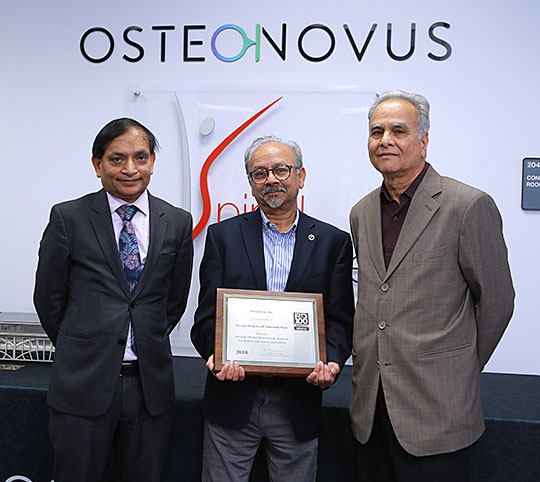A synthetic bone graft substitute developed at The University of Toledo has been recognized by R&D Magazine as one of the year’s most exceptional innovations in science and technology.
Created by Dr. Sarit Bhaduri, UT Distinguished University Professor of Mechanical, Industrial and Manufacturing Engineering, NovoGro is a moldable bone substitute putty used to fill gaps in bone and encourage new bone growth. It is used primarily in complicated fractures that would not otherwise heal properly on their own.

Dr. Sarit Bhaduri, center, held the R&D Magazine award he received for NovoGro, a synthetic bone graft substitute he created with Dr. Anand Agarwal, left, and Dr. Vijay K. Goel. R&D Magazine named their invention as one of the year’s most exceptional innovations in science and technology.
R&D Magazine has annually selected the top 100 revolutionary technologies of the past year since 1963. Among this year’s other winners were Dow Chemical, Texas Instruments, the MIT Lincoln Laboratory, Oak Ridge National Laboratory and NASA’s Glenn Research Center.
“The R&D 100 Award is one of the most prestigious recognitions in applied science,” UT Vice President for Research Frank Calzonetti said. “This award speaks to the ability of Bhaduri and his University of Toledo colleagues in translating highest quality research into marketable products to improve the health outcomes of many.”
Bhaduri teamed up with Dr. Vijay K. Goel, UT Distinguished University Professor and Endowed Chair and McMaster-Gardner Professor of Orthopaedic Bioengineering, and Dr. Anand Agarwal, UT research professor of bioengineering, to license the technology from the University and co-found the biomedical firm OsteoNovus Inc. Agarwal also serves as the president and chief executive officer of OsteoNovus, where the product has undergone further development.
“In this category of orthobiologics — how to grow bone — there are many players, but the problem is the big guys aren’t doing much innovation,” Bhaduri said. “We wanted to disrupt that.”
The U.S. Food and Drug Administration has cleared NovoGro for use in two different indications — spine and the extremities.
Currently, NovoGro has a half dozen clinical users across the country and is trying to grow the client base significantly in 2019.
The company’s corporate offices and manufacturing facility are housed within The University of Toledo LaunchPad Incubation Program.